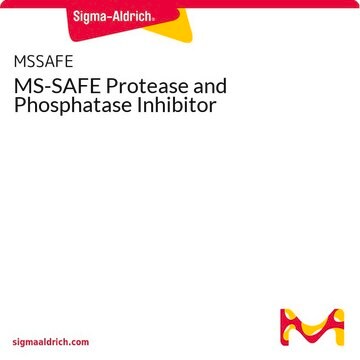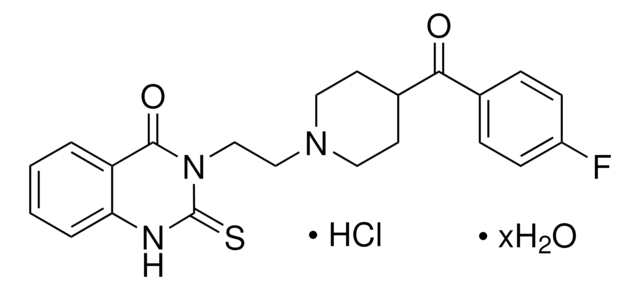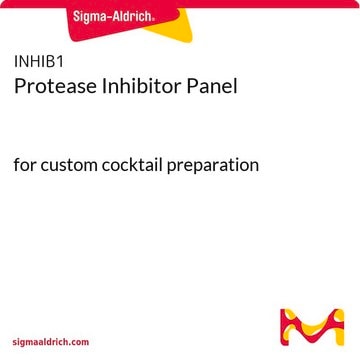SRE0055
Protease Inhibitor Cocktail Powder
Reagents designed and manufactured under cGMP controls suitable for use in an IVD application.
Synonym(s):
Protease Inhibitor Cocktail powder
Sign Into View Organizational & Contract Pricing
All Photos(1)
About This Item
UNSPSC Code:
12352200
NACRES:
NA.32
Recommended Products
biological source
bovine lung
yeast
form
lyophilized powder
storage temp.
−20°C
Looking for similar products? Visit Product Comparison Guide
Specificity
Inhibits serine, cysteine, and metallo-proteases.
Application
Optimized and tested for general use.
Protease inhibitor cocktail powder has been used in immunoblotting and immunoprecipitation.
Protease inhibitor cocktail powder has been used in immunoblotting and immunoprecipitation.
Biochem/physiol Actions
This mixture contains individual components, including AEBSF at 2 mM, Aprotinin at 0.3 μM, Bestatin at 116 μM, E-64 at 14 μM, Leupeptin at 1 μM and EDTA at 1 mM. Each component has specific inhibitory properties.
AEBSF and Aprotinin act to inhibit serine proteases, including trypsin, chymotrypsin, and plasmin amongst others. Bestatin inhibits aminpeptidases. E-64 acts against cystein proteases. EDTA is an inhibitor of metalloproteases. Leupeptin acts against both serine and cystein proteases.
Protease helps to break down proteins into soluble peptides and amino acids.
AEBSF and Aprotinin act to inhibit serine proteases, including trypsin, chymotrypsin, and plasmin amongst others. Bestatin inhibits aminpeptidases. E-64 acts against cystein proteases. EDTA is an inhibitor of metalloproteases. Leupeptin acts against both serine and cystein proteases.
Protease helps to break down proteins into soluble peptides and amino acids.
Components
1 bottle in serum bottle
Components
AEBSF
Aprotinin
Bestatin
E-64
EDTA
Leupeptin
AEBSF
Aprotinin
Bestatin
E-64
EDTA
Leupeptin
Quantity
One bottle makes 100 mL of cocktail, which are sufficient to the inhibition of proteases present in approximately 20 gram of cell extract.
Not all extracts contain the same levels of endogenous enzymes, and it may be necessary to adjust the volume of cocktail required.
Not all extracts contain the same levels of endogenous enzymes, and it may be necessary to adjust the volume of cocktail required.
Preparation Note
This product is supplied as a lyophilized powder. One bottle prepares 100 mL of a cocktail solution.
signalword
Warning
hcodes
Hazard Classifications
Eye Irrit. 2 - Skin Irrit. 2
Storage Class
11 - Combustible Solids
wgk_germany
WGK 3
flash_point_f
Not applicable
flash_point_c
Not applicable
Certificates of Analysis (COA)
Search for Certificates of Analysis (COA) by entering the products Lot/Batch Number. Lot and Batch Numbers can be found on a product’s label following the words ‘Lot’ or ‘Batch’.
Already Own This Product?
Find documentation for the products that you have recently purchased in the Document Library.
Customers Also Viewed
Farhan Younas et al.
Biochimica et biophysica acta. Biomembranes, 1860(8), 1544-1553 (2018-05-23)
Legionella pneumophila is an aerobic and nonspore-forming pathogenic Gram-negative bacterium of the genus Legionella. It is the causative agent of Legionnaires' disease, also known as Legionellosis. The hosts of this organism are diverse, ranging from simple water borne protozoans such
Amina E Essawy et al.
PeerJ, 9, e11930-e11930 (2021-08-27)
Bisphenol A (BPA) is an endocrine disruptor to which humans are often subjected during daily life. This study aimed to investigate the ameliorative effect of astragaloside IV (ASIV) or saponins extracted from Astragalus spinosus (A. spinosus) against DNA damage and
Biology for the IB Diploma: Standard and Higher Level (2001)
Ahmed S Al-Shami et al.
Molecular and cellular biochemistry (2024-06-28)
Bisphenol A (BPA), a common endocrine-disrupting chemical, is found in a wide range of home plastics. Early-life BPA exposure has been linked to neurodevelopmental disorders; however, the link between neuroinflammation, pyroptosis, and the development of psychiatric disorders is rarely studied.
Kai Dai et al.
Frontiers in immunology, 8, 320-320 (2017-04-07)
The mechanisms by which tumor-responsive CD8+ T cells are regulated are important for understanding the tumor immunity and for developing new therapeutic strategies. In current study, we identified the expression of 1810011o10 Rik, which is the homolog of human thyroid
Our team of scientists has experience in all areas of research including Life Science, Material Science, Chemical Synthesis, Chromatography, Analytical and many others.
Contact Technical Service

















